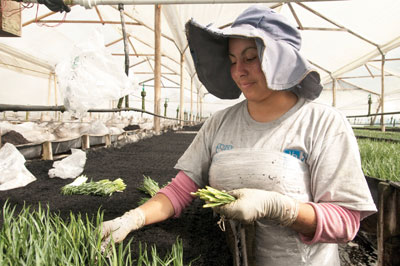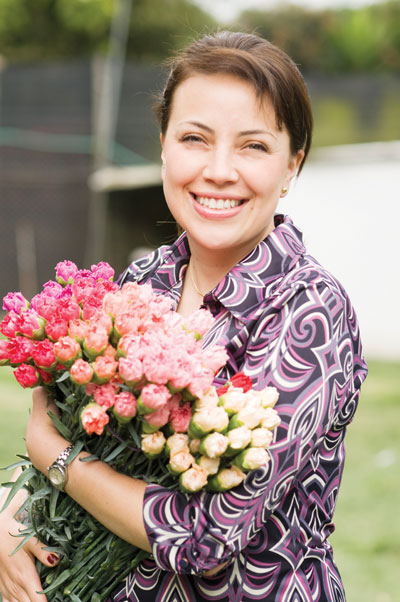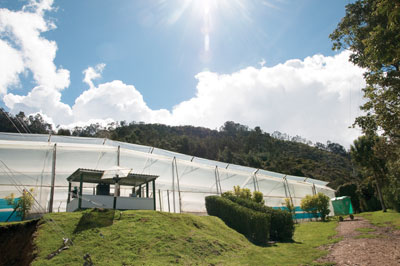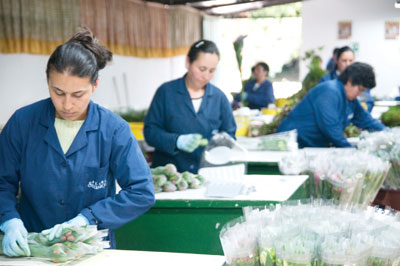
An enormous bouquet of red roses with corollas the size of a child’s hand takes centre stage within a gleaming forest of trophies trumpeting achievements such as Best World Ornamental Grower of the Year, won at an international flower show in Holland.
An enormous bouquet of red roses with corollas the size of a child’s
hand takes centre stage within a gleaming forest of trophies trumpeting
achievements such as Best World Ornamental Grower of the Year, won at
an international flower show in Holland.

|
| planting flowers in a Colombian greenhouse. (ALL PHOTOS, TALLULAH PHOTOGRAPHY) Advertisement
|
The blooms sit on a side table in the boardroom of Colibri Flowers,
which grows these corpulent red ‘Freedom’ roses. At one end of the
boardroom table sits Maria Fernanda Rojas, Colibri’s 31-year-old
managing director, who is discussing the biological controls the farm
uses to control the insect pests that are enlarged many times life size
on a PowerPoint screen.
 |
|
| Maria Fernanda Rojas, managing director of Colibri Flowers |
|
 |
|
| Greenhouses at Colibri Flowers. |
|
 |
|
| Bouquet specialists at Suasuque Flowers. |
Located on the Colombian savannah 2,600 metres above sea level,
Colibri, a picturesque, 45-minute drive west of the capital of Bogota,
is one of the nation’s more progressive greenhouse operations. Colibri,
which produces more than 85 million stems a year, is constantly seeking
to advance its integrated pest management (IPM) system in an
eco-friendly way by improving biological controls for creatures like
those currently being displayed.
WORKER SAFETY STANDARDS OUTLINED IN FLORVERDE
The international standards that Colibri adheres to are set out in the
industry’s Florverde social and environmental program, established by
the Colombian Association of Flower Exporters (Asocolflores).
Florverde, which means “green flower” in Spanish, establishes worker
safety and well-being as well as sustainability standards.
When biological alternatives are not available, Colibri tries to limit
the exposure of its workers to chemicals by ensuring they wear
protective clothing and giving them regular blood tests to monitor
possible contamination levels, says Rojas.
Colibri, which also grows carnations, spray carnations, and herbs like
basil, chives and sorrel on 36 hectares, has its own laboratory, which
monitors fungal and pest contamination throughout the farm. One of the
more simple biological controls used is liquefied garlic spray, a
turnoff to insects (as well as humans). Other biological controls
involve using a predatory insect or fungus to kill off pests. These
include the bacteria, Bacillus thuringiensis, for killing moths, and
the fungus Tricoderma, which kills off a wilt-causing fungus called
Fusarium oxysporum. Colibri also uses the bacteria Bacillus
thuringiensis to kill Agrolis ipsilon, a black cutworm that feasts on
ornamentals. Meanwhile, a soap and water solution is used to control
spider mites.
At Colibri, efforts to be environmentally friendly mean that the
operation has rejected such controversial advances as genetically
modified (GM) flowers. (Japanese growers are producing a GM blue rose.)
Colibri’s flowers, says Rojas, are not genetically modified (GM) and
are certified as such. “If you grow GMs and put the plants into the
ecosystem, you don’t know how it will affect the environment, the birds
and the water,” she says.
VALUE-ADDED PRODUCTS FROM CARNATION WASTE
In an effort to be both competitive and sustainable, Colibri is
creating value-added products like paper made from carnation organic
waste. This carnation paper can be used as flower wrap with a small plastic “window” for viewing the blossoms. As well, almost everything
on the farm is recycled, Rojas says. Plastic containers are cleaned and
reused. Empty chemical containers are returned to the factories, where
the plastic is ground into pellets and made into fencing.
Northeast of Bogota sits Flores Suasuque, a family farm owned by Lucie
de Monchaux de Vélez, 71, who operated the facility with her late
husband, Ernesto Vélez, 72, who died this past March. The farm is
regarded as being the closest to a chemical-free flower operation in
Colombia. At Suasuque, which grows mainly alstroemeria and anigosantos
on 13 hectares, pests are vacuumed up, caught with butterfly nets and
shaken off flower stems. Managers also use a spray mixture of
bicarbonate of soda, chile peppers, garlic and onions for the bugs,
says de Vélez.
WORKERS OFTEN EARN LESS THAN 20 PER CENT OF CANADIAN RATES
Such labour-intensive work is only possible when wages are low.
Colombia flower workers earn less than 20 per cent of what their
Canadian counterparts make. In Colombia, however, these wages are
sufficient to sustain a family. Nonetheless, operations like Colibri
and Suasuque, which has 160 workers, have instituted social programs to
support employees, due in part to an inadequate national social safety
net and a population that has been severely stressed by long-standing
national strife.
Colombia has an estimated three million internally displaced persons
(IDPs) due to a violent civil war stretching back to the mid-1960s,
according to the United Nations High Commission for Refugees.
At Colibri, 30 per cent of the 650 staff members are IDPs. Many are
single mothers. To help ensure their health and well-being, Colibri
ensures the workers receive regular dental work. They are tutored in
personal banking and using ATMs and receive housing assistance, Rojas
says. Colibri also provides subsidized child care for the workers’
children.
’CULTIVATING PEACE IN THE FAMILY’ PROGRAM WIDESPREAD
Australian-born de Vélez developed a unique initiative called
Cultivating Peace in the Family, which has been adopted by other flower
operations. The country’s tragic history of civil war and violence
spilled over into the family, and women were coming to work bruised and
battered, says de Vélez. The program teaches staff how to diffuse
potential conflict at work as well as in the home. “Peace in the
country begins with peace in the family.”
A former nurse, de Vélez also introduced a healthy eating program at
Suasuque. Worried by the prevalence of obesity among workers, whose
diet consisted largely of simple carbohydrates, she introduced
well-balanced lunchtime meals for the employees.
Such a broad range of social and environmental programs by flower
growers are part of a long-standing effort by Colombia to increase its
production of flowers while upholding international standards. Flower
production is important to the Colombian economy; it is second only to
coffee in exports and employs about 200,000 workers.
Colombia boasts ideal growing conditions for both coffee and flowers.
Due to its location in the equatorial tropic zone, Colombia has even
hours of daylight year-round and a consistent average temperature of
13ºC. Backed by strong support from the national government, the flower
sector, worth just over $1 billion a year, is looking to enhance and
refine its competitive advantage globally.
According to Asocolflores president Augusto Solano, Canada comprises
five per cent of total exports while the United States takes the lion’s
share at about 75 per cent.
Solano considers the Canadian market a natural extension of the
American one, saying that it holds great potential for growth.
Canadians’ taste in flowers “is more sophisticated in certain ways”
than Americans’, says Solano. Most people in the U.S. buy flowers only
for special holidays, while Canadians more closely parallel Europeans
who purchase flowers on a more regular basis, Solano says.
EXPORTS TO CANADA HAVE BEEN GROWING
Flower imports from Colombia have, indeed, been ascending, according to
Statistics Canada. Imports in 2009 were $71.8 million, up from $55
million in 2004. The Canada-Colombia Free Trade Agreement (CCFTA) is
expected to further increase the number of Colombian flowers in Canada
as the new legislation removes the duty – up to 10.5 per cent for roses
– previously imposed.
Unfortunately, Canadian growers are feeling the pinch. Many Canadian
rose growers have shut down in the past few years and some industry
experts predict that Canadian-grown alstroemerias will face a similar
fate in the near future.
Roberta Staley is a freelance writer in British Columbia.
Print this page